
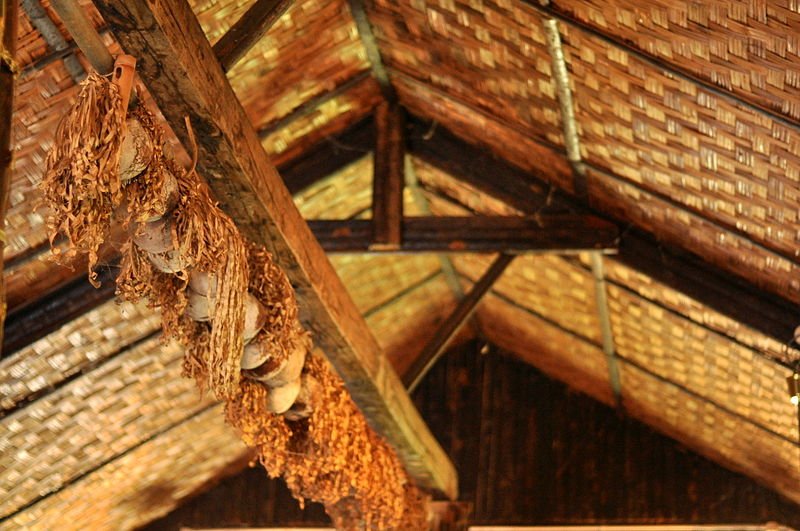 Skulls at the House of Skulls, Monsopiad Cultural Village
Skulls at the House of Skulls, Monsopiad Cultural Village https://commons.wikimedia.org/wiki/File:Monsopiad%27s_Skulls.jpg
https://commons.wikimedia.org/wiki/File:Monsopiad%27s_Skulls.jpg Dcubillas
Dcubillas
Monsopiad Cultural Village is a living museum in Sabah. It provides a glimpse into the lifestyle of the Kadazan-Dusun people, which has 10 different languages and 30 different dialects.
Legend of Monsopiad
The cultural village was named after a legendary Kadazan-Dusun warrior called Monsopiad, who was said to have lived in the village of Kuai, in what is today Penampang district three hundred years ago. He was born to a woman named Kizabon and her husband Dunggou.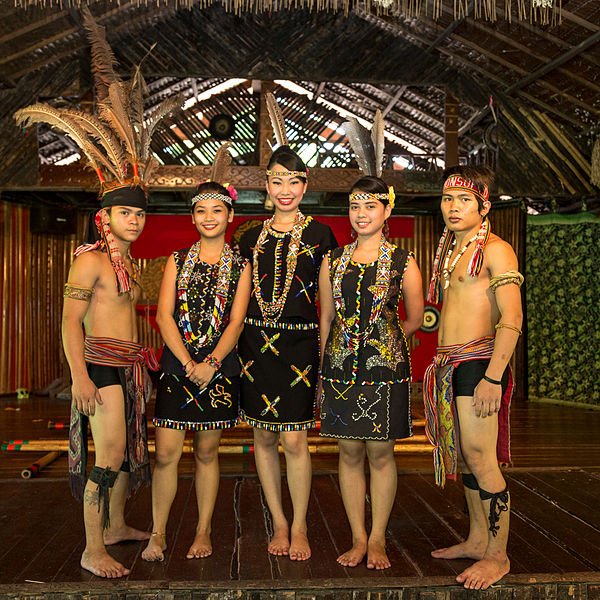 Dancers, Monopiad Cultural Village
Dancers, Monopiad Cultural Village https://commons.wikimedia.org/wiki/File:KgKuaiKandazon_Sabah_Monsopiad-Cultural-Village-24.jpg
https://commons.wikimedia.org/wiki/File:KgKuaiKandazon_Sabah_Monsopiad-Cultural-Village-24.jpg CEphoto, Uwe Aranas
CEphoto, Uwe Aranas
When Kizabon was pregnant with Monsopiad, a Bugong bird, which is sacred to the Kadazan people, decided to make its nest on the roof of their home. On the same day that Monsopiad was born, the Bugong bird also had its eggs hatched. This was taken as a good sign by the Kadazan people.
Monsopiad grew up to became a skillful warrior. His maternal grandfather was the headman of his village. The village was constantly being robbed and plundered by invaders. Each time a raiding party descended on Kuai village, the villagers were forced to flee into the jungle to save themselves.
Angered by the constant raids to his village, Monsopiad vowed to hunt down the raiders and bring back their heads. Through the magical powers he received from the Bugong bird, he was able to trek down, attack and execute all the raiders. When Monsopiad returned victorious, he was given a tremendous welcome. Unfortunately it not only boosted his pride, it also inflated his ego.
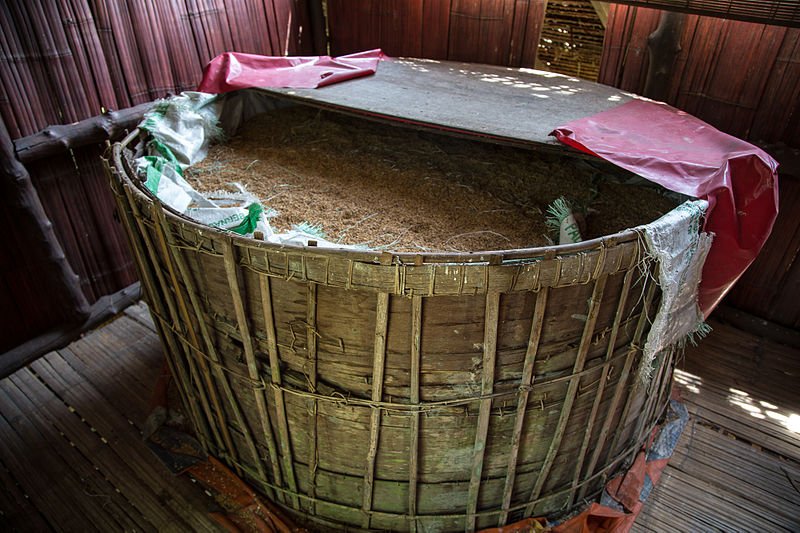 Rice storage drum, Monopiad Cultural Village
Rice storage drum, Monopiad Cultural Village https://commons.wikimedia.org/wiki/File:KgKuaiKandazon_Sabah_Monsopiad-Cultural-Village-09.jpg
https://commons.wikimedia.org/wiki/File:KgKuaiKandazon_Sabah_Monsopiad-Cultural-Village-09.jpg CEphoto, Uwe Aranas
CEphoto, Uwe Aranas
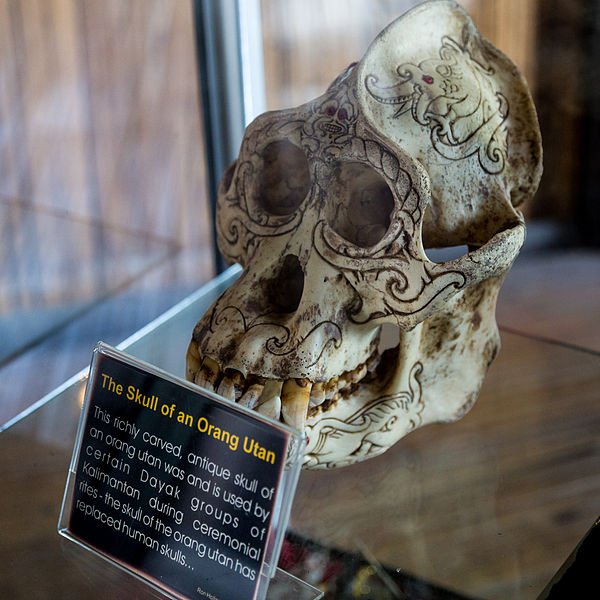 Antique orang utan skull, Monopiad Cultural Village
Antique orang utan skull, Monopiad Cultural Village https://commons.wikimedia.org/wiki/File:KgKuaiKandazon_Sabah_Monsopiad-House-of-Skulls-10.jpg
https://commons.wikimedia.org/wiki/File:KgKuaiKandazon_Sabah_Monsopiad-House-of-Skulls-10.jpg CEphoto, Uwe Aranas
CEphoto, Uwe Aranas
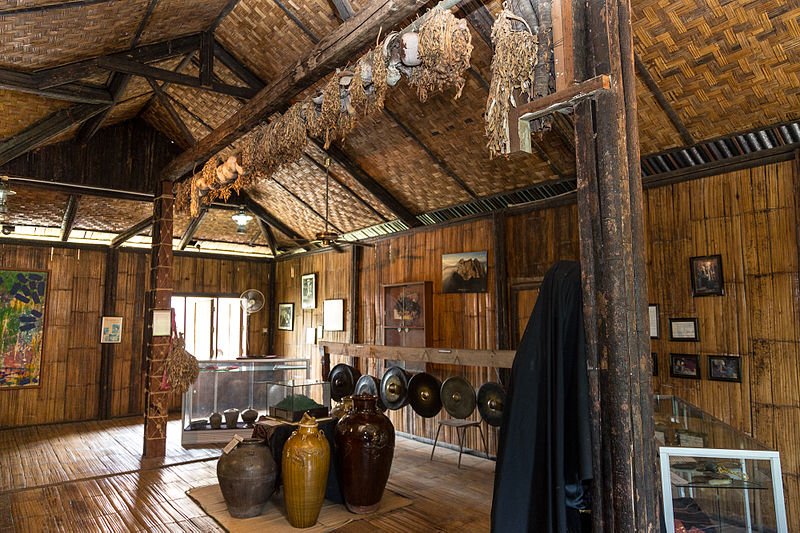 House of Skulls
House of Skulls https://commons.wikimedia.org/wiki/File:KgKuaiKandazon_Sabah_Monsopiad-House-of-Skulls-06.jpg
https://commons.wikimedia.org/wiki/File:KgKuaiKandazon_Sabah_Monsopiad-House-of-Skulls-06.jpg CEphoto, Uwe Aranas
CEphoto, Uwe Aranas
Although the village was now safe from raiders, the young warrior was soon turning on the villagers themselves to satisfy his thirst for heads. He would pick fights with fellow villagers, just so that he could kill and behead them. The villagers admiration of Monsopiad soon turn to fear and dread, and they got together to plot a way to liquidate him. Some of the best fighters of the village was selected to execute Monsopiad. When they attacked Monsopiad, he fought bravely, but some how the magical powers that the Bugong bird had bestowed upon him had petered away when he abused the powers, and so the villagers were able to put down Monsopiad. The villagers mourned the loss of their best warrior in their own hands, and they erected a memorial to him.
The Monsopiad Cultural Village is said to have been established by the descendents of Monsopiad, if indeed he fathered any offsprings. Within the House of Skull of the cultural village are 42 human skulls that were said to have been the trophies collected by Monsopiad.
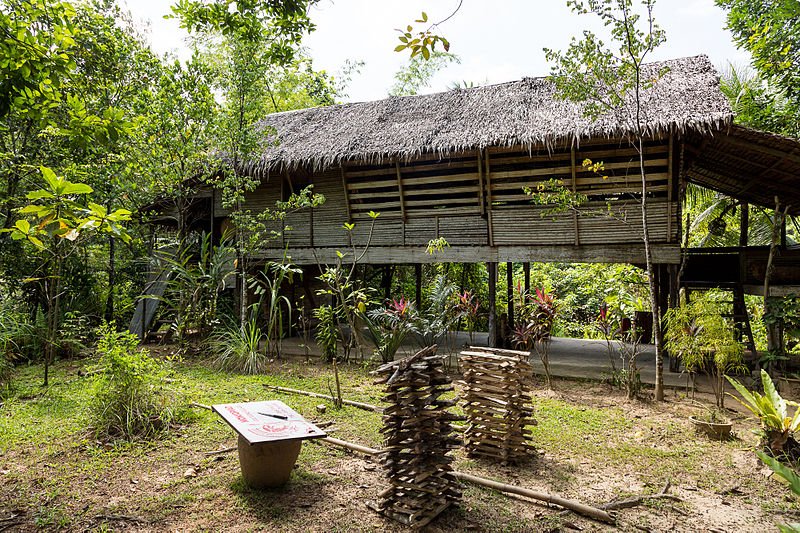 A traditional dwelling, Monopiad Cultural Village
A traditional dwelling, Monopiad Cultural Village https://commons.wikimedia.org/wiki/File:KgKuaiKandazon_Sabah_Monsopiad-Cultural-Village-07.jpg
https://commons.wikimedia.org/wiki/File:KgKuaiKandazon_Sabah_Monsopiad-Cultural-Village-07.jpg CEphoto, Uwe Aranas
CEphoto, Uwe Aranas
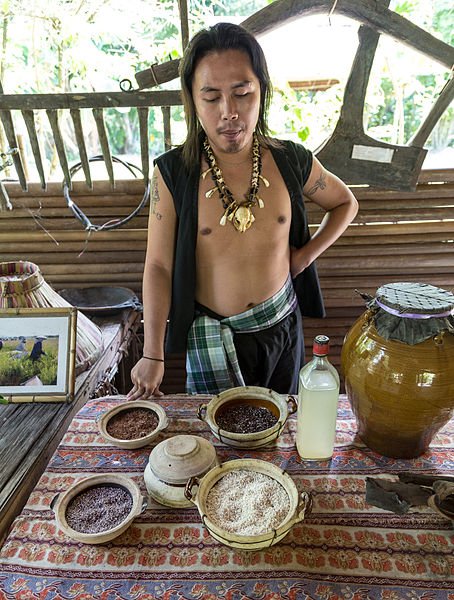 Different types of rice, Monopiad Cultural Village
Different types of rice, Monopiad Cultural Village https://commons.wikimedia.org/wiki/File:KgKuaiKandazon_Sabah_Monsopiad-Cultural-Village-15.jpg
https://commons.wikimedia.org/wiki/File:KgKuaiKandazon_Sabah_Monsopiad-Cultural-Village-15.jpg CEphoto, Uwe Aranas
CEphoto, Uwe Aranas
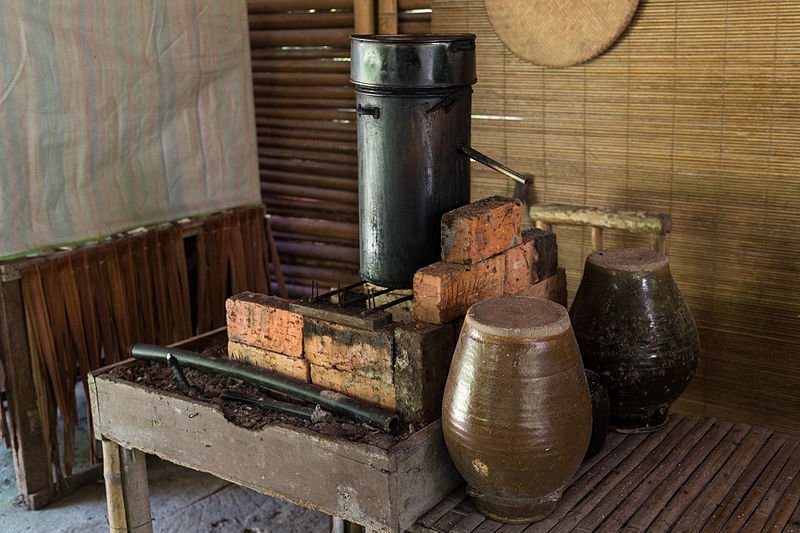 Stove for making rice wine, Monopiad Cultural Village
Stove for making rice wine, Monopiad Cultural Village https://commons.wikimedia.org/wiki/File:KgKuaiKandazon_Sabah_Monsopiad-Cultural-Village-16.jpg
https://commons.wikimedia.org/wiki/File:KgKuaiKandazon_Sabah_Monsopiad-Cultural-Village-16.jpg CEphoto, Uwe Aranas
CEphoto, Uwe Aranas
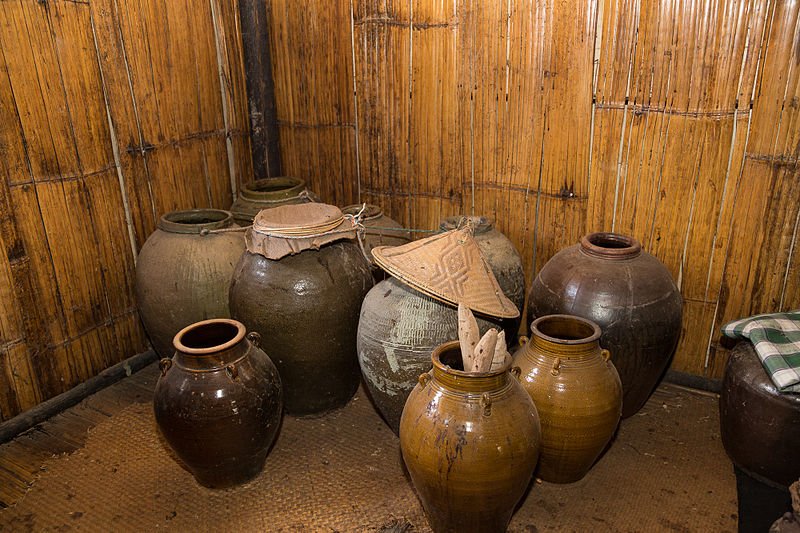 Jars for storing tapai, the fermented rice wine, Monopiad Cultural Village
Jars for storing tapai, the fermented rice wine, Monopiad Cultural Village https://commons.wikimedia.org/wiki/File:KgKuaiKandazon_Sabah_Monsopiad-Cultural-Village-12.jpg
https://commons.wikimedia.org/wiki/File:KgKuaiKandazon_Sabah_Monsopiad-Cultural-Village-12.jpg CEphoto, Uwe Aranas
CEphoto, Uwe Aranas
Contact
Monsopiad Cultural Village Sdn BhdKampung Kuai/Kandazon, Penampang
P.O. Box 153 Tanjung Aru 89458
Kota Kinabalu, Sabah
Phone: 088 774 337
Website: www.monsopiad.com
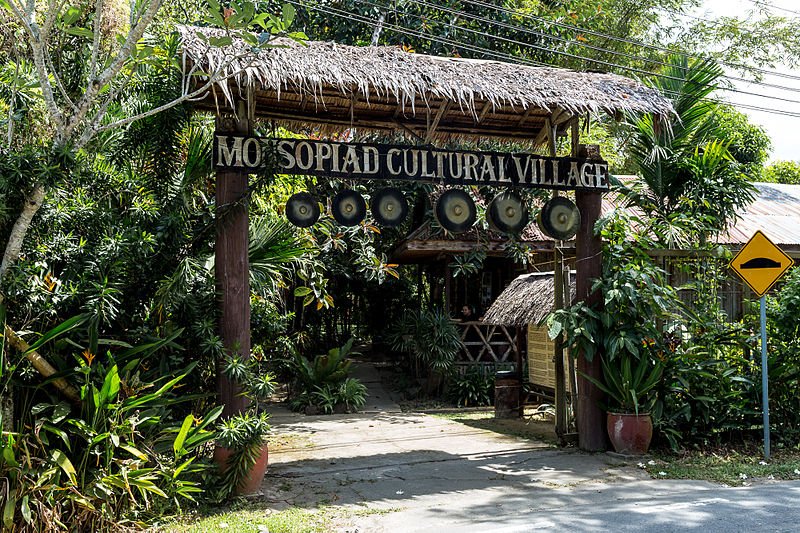 Entrance, Monsopiad Cultural Village
Entrance, Monsopiad Cultural Village https://commons.wikimedia.org/wiki/File:KgKuaiKandazon_Sabah_Monsopiad-Cultural-Village-01.jpg
https://commons.wikimedia.org/wiki/File:KgKuaiKandazon_Sabah_Monsopiad-Cultural-Village-01.jpg CEphoto, Uwe Aranas
CEphoto, Uwe Aranas
Entrance Fees
Non-Malaysian VisitorsAdults: RM75
Students: RM50
Children (4-12 years old): RM25
Children below 4 years old: free of charge
Malaysian Visitors
Adults: RM55
Students: RM30
Senior Citizens (55 years old and above): RM20
Children (aged 4 to 12 years old): RM10
Children below 4 years old: free of charge
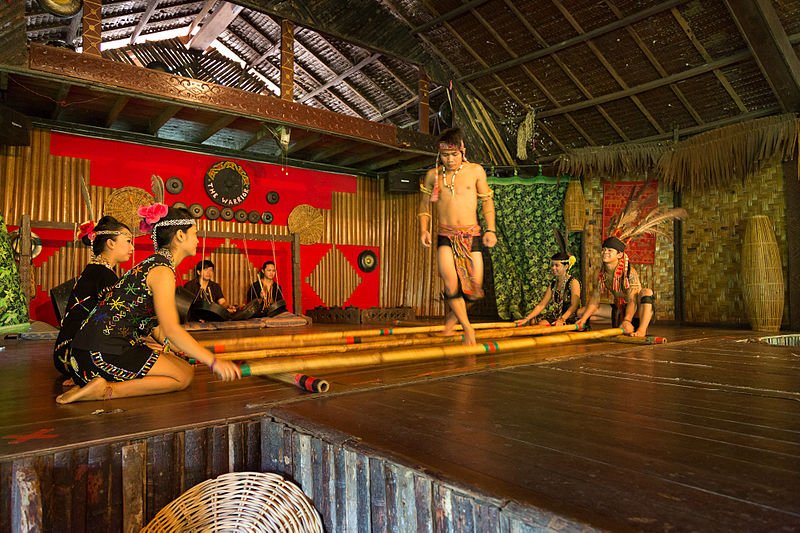 Bamboo dance, Monsopiad Cultural Village
Bamboo dance, Monsopiad Cultural Village https://commons.wikimedia.org/wiki/File:KgKuaiKandazon_Sabah_Monsopiad-Cultural-Village-DansePerformance-15.jpg
https://commons.wikimedia.org/wiki/File:KgKuaiKandazon_Sabah_Monsopiad-Cultural-Village-DansePerformance-15.jpg CEphoto, Uwe Aranas
CEphoto, Uwe Aranas
Activities at Monsopiad Cultural Village
Visitors to Monsopiad Cultural Village get to learn about the way of life of the Kadazan-Dusun people. At the same time, they get to try out some of the rural activities including shooting with a blowpipe (called monopuk), shooting with catapult, stilt walking (tampanau). They also get to participate in domestic activities such as sago grating (called mamagalus) and collecting sago grub (called butod). There are demonstations on rice wine making, starting fire, and other domestic chaos.Cultural performances are staged at 9:30 am, 11:00 am, 2:00 pm and 4:00 pm.
Getting there
Monsopiad Cultural Village is located about half an hour from Kota Kinabalu. The cultural village provides a shuttle service to pick up visitors from their hotel.List of Cultural Villages in Malaysia
 Latest updates on Penang Travel Tips
Latest updates on Penang Travel Tips
 Discover with Timothy videos on Sabah
Discover with Timothy videos on Sabah
What to see when in Sabah? Here are some suggestions from my videos.Disclaimer
Please use the information on this page as guidance only. The author endeavours to update the information on this page from time to time, but regrets any inaccuracies if there be any.About this website

Dear visitor, thank you so much for reading this page. My name is Timothy Tye and my hobby is to find out about places, write about them and share the information with you on this website. I have been writing this site since 5 January 2003. Originally (from 2003 until 2009, the site was called AsiaExplorers. I changed the name to Penang Travel Tips in 2009, even though I describe more than just Penang but everywhere I go (I often need to tell people that "Penang Travel Tips" is not just information about Penang, but information written in Penang), especially places in Malaysia and Singapore, and in all the years since 2003, I have described over 20,000 places.
While I try my best to provide you information as accurate as I can get it to be, I do apologize for any errors and for outdated information which I am unaware. Nevertheless, I hope that what I have described here will be useful to you.
To get to know me better, do follow me on Facebook!
Copyright © 2003-2025 Timothy Tye. All Rights Reserved.

 Go Back
Go Back